“Introduction”
Hi and welcome back to what is already the fifth installment in this series on European MB Transformers, where we take an in depth look at everything you would ever want to know (and probably more) about this toy line. In the previous couple of articles we looked at the history of MB and other players, that were actively involved with the European introduction of transforming robot toys from Japan. You don’t need to have read all the previous articles in order to be able to understand this one, but it sure helps!
This fifth installment is the first of a sub-series called “MB Mysteries & Variants”. There are so many weird things going on with the MB Transformers line and many questions unanswered (or insufficiently answered) that I thought it would be a good idea to try and explain them as much as I’m able to or at least give my opinion on what I think was going on and take away some common misconceptions along the way. The first mystery we’re going to sink our teeth into relates to one of the most often heard questions and that is; Why is Jetfire the leader of the Autobots and not Optimus Prime?
“The Jetfire vs Optimus Prime mixup”
One of the most well known mysteries that surrounds the MB Transformers line was the Jetfire vs Optimus Prime leadership issue. For some reason MB decided to make Jetfire the leader and not Optimus Prime. It’s a mystery that continues to exist to this day, because quite frankly, no one has been able to deliver a water tight case to explain it.
“I am the leader!” – “No, *I* am the leader!”
Several attempts have been made over the years to clear up this confusion. Most of these revolve in some way around an alledged trademark dispute in the Netherlands in 1985 surrounding the name Optimus Prime. These explanations depend on the assumption that MB (or Hasbro) were not able to secure a trademark for the name “Optimus Prime” for the Dutch market, because it was owned by a Swedish maker of stoves called Optimus. Because of this, the theory goes, the introduction of Optimus Prime was held back by MB in Europe until this alledged trademark issue would have been resolved. In the meantime MB made Jetfire the leader. Variations on this theory exist, but this is really the gist of it. One thing that all these theories have in common is that they do not cite any verifiable sources that support them.
Photograph of evil stoves with special Optimus Prime-blocking powers
Astute readers will have noticed my careful choice of wording in the above paragraph. :-) It may come as no surprise that I do not agree with the afforementioned theory. In fact, I believe there was no trademark issue there at all and there was nothing which would have prevented the use of the name Optimus Prime in Europe, including the Netherlands. I believe the true reason why MB chose Jetfire as the leader of the Autobots instead of Optimus Prime lies somewhere else. Also, the claim that the release of Optimus Prime in Europe was held back deserves some nuance as we will see in this article.
To fully understand the complexity of this issue, it is necessary that I preface this article with a primer on three important legal concepts, which are so often confused by more or less everyone I know. Including me! Until I finally sat down and boned up on international intellectual property laws, that is! The three legal concepts I am referring to are:
- Copyrights
- Patents
- Trademarks
Yeah, I know, learning stuff sucks! But in this case it is inevitable that we grasp the basic meaning of these three concepts, so that we may apply this knowledge to this case without any confusion. I believe it is exactly this confusion and blurring of these three concepts that is directly responsible for the prevalent theory that this was all due to a trademark dispute. If you’re already very familiar with trademark law, patents and copyrights, you can just skip the next three sections and feel rather smug about yourself.
“Copyright”
Right, let’s start off with the most recognizable and easy to understand concept, that of copyright. As the name would imply it is the exclusive right to copy or reproduce something. This “something” is an original work of art, like a painting, a book, a sound recording, a movie, etc. The shape of Optimus Prime is a real life example of a work that is protected by copyright.
A million years ago, in the 19th century, copyright was already a concern, especially in the world of print, because although most developed countries had some sort of copyright law, these differed wildly between nations and often relied on explicit registration of the work in question in order to obtain the copyright. Also, copyright protection was only valid in the country where you would apply for it. It was a total mess. And that’s why in 1886 a convention was held in Berne, Switzerland to draw up an international agreement regarding copyright. This is now known as the “Berne Convention for the Protection of Literary and Artistic Works” or, simply, the Berne Convention.
Photo of people chilling out in Bern, Switzerland
Two very important things were codified at the Berne Convention:
- Every country that signed the Berne Convention would agree to recognize the copyright of authors from all the other countries that have also signed this agreement, in the exact same way that it would recognize the copyrights of its own citizens.
- It is not necessary to register a copyright. Copyright exists automatically as soon as an original work has been created. The author of the work immediately owns the copyright as soon as he has created it.
A similiar international copyright convention existed, which was held in 1952 in Geneva and is called the Universal Copyright Convention. It was signed by several developing countries who disagreed with the Berne Convention, but still wished to participate in an international copyright agreement.
International copyright notice on MB Beachcomber packaging
The US did not sign the Berne Convention until 1988. Instead, in the US it was necessary to register a work at the US Copyright Office and to place a copyright notice on the work itself in order to enjoy copyright protection. This has made the copyright symbol © a world famous symbol. Today, the copyright notice is superfluous in the sense that it does not carry any added legal meaning other than to let you know that the work is protected by copyright. Even without the copyright notice, the work is protected. It has been like that in most developed countries since 1886 (and since 1988 finally also in the US. ;-)
“Patent”
Something which is related to copyright, but is really something different is a patent. A patent is not the protection of an original work, such as a book or sound recording, but of an invention (or idea). Inventions are more abstract than art works and enjoy a significantly shorter protection span than copyrighted works. To illustrate this with a real life example, let’s look at Optimus Prime again. When Optimus Prime’s mould was created by Takara they applied for a patent. A patent was filed in 1984 at the US Patent Office (#4516948) that contained a fairly accurate description of the parts that Optimus Prime consisted of and how he could be transformed from truck into robot and vice versa.
US patent for Optimus Prime (#4516948)
This patent is different from the copyright that existed on the exact shape of Optimus Prime! How? The patent that Takara had protected them against competitors from creating a very similiar robot toy that could be transformed into a truck using roughly the same design and by employing roughly the same operations to transform him. The copyright on Optimus Prime is based on his exact shape. Copyright law protects Takara from anyone making a toy that looks (almost) exactly like Optimus Prime. The Optimus Prime patent protects Takara against anyone making a transforming robot that is similiar to Optimus Prime.
See the big difference there? A patent protects an invention, an idea, which is very broad. Copyright protects a specific instance of this invention or idea. A patent gives much broader protection than copyright. That is also why patents are much more limited with regards to their life span, usually about 20 years, whereas copyrights are valid up to 90 years after the death of the creator and we’re looking at the realistic possibility of copyrights becoming indefinite due to the copyright mafia’s lobbying.
Contrary to copyright, which grants the owner the sole right to reproduce (copy) or adapt an original work, a patent works the other way around. It is a right which allows the inventor to exclude others from making, selling or importing the invention. The reasoning behind this broad protection is to encourage inventors to share their invention with humanity by registering it at a patent office. In return they get the exclusive right to this invention for 20 years (or more), after which it falls into the public domain and humanity can benefit from the invention. It’s a simple trade off.
“Trademark”
Lastly, a trademark is a word, a logo, a sign or image (or a combination of those). It is used by a person or a company to distinguish itself from others in their trade. An example of a trademark is the name “Hasbro” and the Hasbro logo. Another example is the name “Transformers” and the various Transformers logos that we’ve seen over the years. If every company in the world were allowed to name themselves Hasbro, how would you know that the product you are buying from a Hasbro is from the original Hasbro from Pawtucket, Rhode Island in the US? Trademark law allows companies to register their name so that no one else can use it, thus preventing confusion in the market and allowing companies to protect their brands.
Hasbro logo, protected as a trademark
But there’s one snag. Let’s say you have a company called Hasbro that makes toys. And let’s say you also have another company called Hasbro that makes boats. In that case, there is little confusion about which Hasbro is which. Buyers of Hasbro toys are not likely to confuse the toy maker Hasbro with the boat maker Hasbro and vice versa. So in order to make trademark law reasonable, a system was devised where trademarks could be applied for specific categories to which the goods or services that needed trademark protection belonged. This is also known as the Nice Classification (“Nice” as in the city of Nice, France). This Nice Classification is an international system which classifies goods and services into 45 categories/classes. Trademarks can be applied for one or more of these classes. E.g. class 28 is known as the category for toys, class 12 is for vehicles, class 13 is for firearms, etc. So, e.g. the name Hasbro has been registered as a trademark for class 28 (toys) in most countries of the world.
The Benelux trademark registration for the name “Hasbro”
“Sales and distribution exclusivity”
We’re not done yet. There’s still one more legal concept that I would like to highlight. I know, I lied when I said I just wanted to discuss three legal concepts. :-) It concerns exclusivity on a contract level. While copyrights, patents and trademarks are rights that are provided by a state or government, there are also other exclusive rights that may arise from private contracts. Again, the best way to illustrate this is to take Optimus Prime as an example. Although there is no law which says that one single company has the right to distribute or sell Optimus Primes in a certain country, it is perfectly possible for the creator of Optimus Primes to enter into a contract with another party, which gives this other party the exclusive right to distribute and/or sell Optimus Prime in a specific country.
And this is exactly what happened in 1983! In June of 1983 the Tokyo Toy Show was held in Japan where Takara were pimping their Diaclone robots. They got a lot of international attention. Hasbro, Ceji and GiG were all interested and struck deals with Takara to gain exclusive rights to distribute and sell these toys in their respective markets. How do we know these were exclusive contracts? Well, because this is the usual way of doing business. But we also have confirmation in the form of court documents from the 1980’s, which reveal details about the contracts between Takara and Hasbro. Court documents are great sources of information in that way, as they can sometimes expose interesting information from contracts, that would otherwise forever have remained hidden from the public.
There was a court case in the US in 1985 between Wales Industrial, Inc and Hasbro Bradley, Inc. regarding the unauthorised selling of several Transformers toys by Wales Industrial. Basically Wales were selling knock-offs of Slag, Sludge, Grimlock, Topspin and Perceptor. In this court case we learn that Takara, the manufacturer and original copyright holder of the Transformer toys, has granted Hasbro an exclusive sales license on November 1st, 1983 for the US market. This means that Takara has granted Hasbro the exclusive rights to sell Transformers toys in the US from that date. (The court document explains that Takara also later transferred their copyrights to the Transformers to Hasbro on November 12, 1984. But that is irrelevant here).
Excerpt from Wales Industrial vs Hasbro Bradley case
If Takara granted Hasbro an exclusive license to sell their transforming robots in the US, it is a safe assumption that similiar deals were struck with GiG and Ceji Joustra. GiG will have gotten an exclusive right to sell these toys in Italy and Ceji will have secured a deal that would have given them an exclusive right to sell these toys in a large part of continental Europe (France, Germany and the Benelux countries, maybe also others). This is very relevant information if we are to understand the issues surrounding Optimus Prime’s release in Europe.
“Optimus Prime trademark”
Now that we have looked at the differences between copyrights, patents and trademarks and the practice of exclusive distribution it is high time we shift our focus back to this alledged trademark dispute regarding the name “Optimus Prime” in the Netherlands, which would’ve been the reason why the toy’s release was delayed and why Jetfire was chosen as leader in the meantime. As I have alluded to at the beginning of this article, I do not believe there ever was a trademark issue regarding the name Optimus Prime in the Netherlands. There are several reasons why:
- Trademarks are not applied for the Netherlands alone. Since 1971 trademarks can only be applied for the whole of the Benelux area (i.e. Belgium, Netherlands and Luxembourg). If a trademark application issue regarding the name “Optimus Prime” existed in 1985 in the Netherlands, this same issue would have existed for the Belgian market and the Luxembourg market. All trademark dispute theories seem to revolve around the Netherlands and none of them mention Belgium or Luxembourg.
The Benelux Office for Intellectual Property (BOIP) – The Hague, Netherlands
- There is no record of the name “Optimus Prime” or “Optimus” being registered at the Benelux trademark office for class 28 (toys), current or expired. There is a registration for the name “Optimus”, that predates 1985, but this is for class 11, which is defined as “Apparatus for lighting, heating, steam generating, cooking, refrigerating, drying, ventilating, water supply and sanitary purposes.” It is obvious that this is the trademark that belongs to the famed Optimus of Sweden. But as this is a class 11 trademark, this means there is no reason why the name “Optimus Prime” could not be registered as a class 28 toy trademark for the Benelux countries in 1985.
- There is also no record of Hasbro nor MB ever applying for the trademark “Optimus Prime” at the Benelux trademark office. An application for a trademark can be contested and the trademark can be denied because of this. If this happens, a record would exist stating the contesting party and the ultimate denial of the trademark application. Hasbro did know its way around the Benelux trademark office and used it to register the name “The Transformers”. This was applied for on the 27th of August 1985 and granted on the 1st of May 1986.
The Benelux trademark registration for the name “Transformers”
- There are no Dutch newspaper articles from the mid-1980’s that mention anything about trademark disputes regarding the name “Optimus” or a variation thereof. It is highly unlikely that if there ever were a trademark dispute about the name “Optimus” that it would have been deemed worthy of an article by the Dutch press, because quite frankly, it’s not exactly an earth shattering occurrence. Nevertheless, I have explored this avenue and searched online archives of a dozen Dutch newspapers and came up empty handed.
- Swedish stove maker Optimus also holds/held trademarks to their name in several other European countries. One would expect to find the same trademark dispute in those countries as well. No trademark disputes involving Hasbro/MB are registered at those trademark offices.
- And finally, if the name “Optimus Prime” is such a problem, why not simply give him another name and be done with it? Why scrap the release of the entire toy simply because you can’t use the name? It was quite common in the 1980’s for G1 Transformers to have different names on the international market, so that was definitely an option.
“The Juniorpress explanation”
So where did these allegations of a trademark dispute regarding the name “Optimus Prime” in the Netherlands come from? I believe this occurred in two steps. In my opinion, the source of all these rumours can be traced back to issue number 5 of the Transformers comic that was published in the Netherlands in the first week of April 1987. Juniorpress is the name of the publisher that was responsible for publishing translated Marvel comics in the Netherlands and in the Dutch speaking parts of Belgium (Flanders) between 1978 and 2007. Because of their exclusive Marvel contracts for Dutch speaking territories, it was logical that Juniorpress were approached by MB in early 1985 for the translation of Marvel’s Transformers comics into Dutch.
Transformers #1 – Dutch version (Juniorpress) and US version (Marvel)
Juniorpress translated and released the initial 4-issue Marvel limited series Transformers in 2 issues. Each issue contained two translated Marvel issues. The first issue was released in the Netherlands in October of 1985 and the second issue was released in November (Belgium probably got them several months later, because due to distribution issues Belgium always got Juniorpress comics 6 to 8 months after they were released in the Netherlands).
What is especially of note here, is the fact that the first issue of the Dutch Transformers comics was released in October 1985. This coincided with the introduction of the toy line in the Netherlands and the premiere of the Transformers cartoon on Sky Channel. Going by evidence in the form of letter pages in various Juniorpress comics in the 1980’s and beyond it was a fact that there was a lead time of at least 4 or 5 months between editing a comic and releasing it in the Netherlands (which was not uncommon for those days). Calculating back from October, this means that editing and translations by Juniorpress for the first issue of the Dutch Transformers comic must have taken place as early as May 1985. Many months before the toy line’s introduction. If you’ve read the previous installments of this article series you might remember that MB initially only planned on releasing what is now known as wave 1. MB’s wave 1 contained very little of the early Transformers. One of the most conspicuous absentees from MB’s wave 1 was Optimus Prime.
At that time, around mid-1985, when Juniorpress started their work on translating the American Marvel comics into Dutch, it must have been clear to them that Optimus Prime was not going to be part of the toy line in the Netherlands (or continental Europe for that matter). Their working relationship with MB would have given them insight to this fact. So, because Juniorpress knew that the Optimus Prime toy would not be available in the Dutch market they decided to do something rather silly and that was to replace every mention in the comics of the name “Optimus Prime” with “Jetfire” in their translation.
Examples of Optimus Prime called Jetfire in Dutch comics
This made an already confusing situation in the Netherlands even more confusing. Kids could watch the Transformers cartoon on Sky Channel every weekend, where Optimus Prime was clearly the leader. But MB’s Transformers pack-in catalog and store catalog (the mini-comic book) showed Optimus Prime missing from the lineup and showed Jetfire as leader of the Autobots. And now here we have the translated Transformers comics available in Dutch supermarkets and kiosks that feature Optimus Prime, but show him being referred to as Jetfire all the time! Three sources that were all contradicting each other in some way. As a kid I desperately tried to make sense of this situation. I assumed that Jetfire was the real leader of the Autobots, because hey, it said so in the catalog! The fact that I saw my hero Optimus Prime leading the Autobots every weekend on the cartoon did not sit well with me, but I just assumed that Jetfire was running the show from Cybertron or something, which would explain why we never saw him on Earth and that Optimus Prime was his subordinate. I was not the only one trying to shoehorn these contradictions into something logical in 1985. Nearly everyone that I knew back then who was into Transformers (and that was almost everyone my age back then) had their own opinion about this leadership question.
Finally, in issue number 5 of Transformers from Juniorpress (which contained translated versions of the original Marvel Transformers comics numbers 9 and 10) an important editor’s note was included on the inside of the cover. It featured an explanation for consistently referring to Optimus Prime as Jetfire in the previous four issues. Here’s the original page (on the left) and a translated version that I made (to the right). Click for bigger version:
Juniorpress editor’s note in Transformers #5 – April 1987
It is pretty clear to me that the rumours about a trademark issue surrounding the name Optimus Prime in the Netherlands originated from this documented evidence. However, if we take a closer look at the actual wording of this editor’s note we discover that it doesn’t really make a lot of sense! The first factual error in there is the fact that it claims there was an issue with the copyright to the name Optimus Prime. Now, as we’ve seen at the beginning of this article it’s impossible to claim copyright on a name! Names cannot be protected by copyright law. Names can only be protected as trademarks. This is a pretty universal legal concept that was also true in 1985 and long before.
Inconsistency #1 in Juniorpress editor’s note
The second discrepancy of note is that the editor’s note claims that two toy lines were introduced in the US. One of them holding the “copyright” to Optimus Prime and the other that did not. Disregarding the inconsistency of the copyright thing for a minute, which two toy lines are they referring to here? There was just one Transformers line in the US, wasn’t there? And what does the word “simultaneously” refer to? The two toy lines? Or the cartoon, the comic book and the two toy lines altogether? This editor’s note actually raises more questions than it answers.
Inconsistency #2 in Juniorpress editor’s note
Does that mean that this editor’s note by Juniorpress is a load of crock? Well, no. I believe this editor’s note holds an important kernel of truth that got mangled up somehow. But before we try and figure out what that is, I first want to focus on something else. It is particularly noteworthy that nowhere in this editor’s note there is a mention of a Scandinavian manufacturer of stoves or kitchen utensils called Optimus. So how was the leap made from this editor’s note to the theory that Optimus Prime was delayed due to a trademark dispute with Optimus of Sweden?
While I believe this editor’s note was the source of the confusion, due to its ambiguous explanation, I suspect there was an additional factor that confused it even further and that was the involving of this Scandinavian manufacturer of stoves and related products called “Optimus” by someone in the early years of this millennium, which is when the first theories involving this manufacturer started to pop up. I have dug through many, many Usenet and mailing list archives and unfortunately I have not been able to pin point the exact beginning of these rumours, but somewhere along the way, the popular stance became that MB was not able to secure a trademark for the name Optimus Prime in the Netherlands, because of this Swedish company called Optimus already having claimed that name. UPDATE: It might very well have been this page/mail exchange that started it all (Thanks to Nevermore for the link!)
By looking at the information available to us at the Benelux trademark offices, we have already seen that there was no reason at all why MB (or Hasbro) would not have been able to secure the trademark for Optimus Prime in the Benelux countries for a toy. The trademark for the name Optimus was held by the Swedish company of the same name, but NOT for the toy category (class 28). This means that the name “Optimus Prime” was available in the Benelux.
Here’s how I think this theory came to light. Somewhere in the early 2000’s someone in the Transformers fan community, most likely a Dutch person, was aware of the fact that Optimus Prime was initially unavailable in the Netherlands. He (or she) was also aware of the Juniorpress editor’s note and decided to consult the Benelux trademark office records regarding the name Optimus Prime and came up with the registration for the name Optimus by the Swedish manufacturer of the same name. This person was probably unaware of the fact that trademark registrations can be applied for various classes of products or services and erroneously put two and two together and deduced that this was the reason why Optimus Prime could not be released in the Netherlands. This story was propogated on Usenet, mailing lists, and many forums and websites ever since, without anyone actually bothering to check up on the facts. An urban myth has been created.
“So What Really Happened Then?”
I guess it’ll come as no surprise that I have a theory of my own regarding this whole Optimus Prime and Jetfire thing. As I’ve mentioned earlier, I believe there is a kernel of truth to the Juniorpress editor’s note, but the information just got misinterpreted somewhere along the way, which is not so surprising considering the fact that copyrights, trademarks and patents are easily confused. An important clue to solving the Optimus Prime vs Jetfire leadership and naming issue (in my opinion) lies again with our famed maker of toys from Strasbourg: Joustra!!!
As we’ve read at the beginning of this article, Hasbro arranged an exclusive agreement with Takara to sell their transforming robots in the US in 1984. We know for a fact that in continental Europe these same toys were sold in 1984 and 1985 by Ceji Joustra. While Hasbro was selling these toys in the US in 1984, in continental Europe a lot of these same toys were being sold by Joustra under the name Diaclone under direct license from Takara. It is unlikely that Joustra did so in any other way than under an exclusive license from Takara. This means that in 1984 and 1985 Joustra had the exclusive right to sell the toys that we now know as Optimus Prime, Jazz, Prowl, Tracks, Starscream, Ravage, Laserbeak, Ratchet and many others in France, Germany and the Benelux countries (and possibly several other European countries). Let that sink in for a moment….
When MB was gearing up to release the first Transformers in continental Europe in 1985, they had a little legal problem. Takara, the original manufacturer of these toys, had already given away the exclusive rights to many of these Transformers to a Ceji Joustra, who was selling them in 1984 and 1985. So what did MB do? Well, they initially decided to settle on just releasing all the Transformers that Ceji Joustra did not have the rights to. This meant that it was impossible for MB to release anything that Joustra had released, which was this:
Joustra Diaclone pre-Transformers – waves 1 and 2 (1984-1985)
Ouch! So what was left? Well, Joustra did not hold the rights to Megatron and Soundwave, so these were added to MB’s introductory line up of the Transformers. What remained were all those 1985 toys to which Joustra obviously did not hold the rights like the Constructicons, the Triple Changers, the Insecticons and all the other bots that we now recognize as MB’s wave 1!
MB Transformers line – wave 1 (1985)
So what I believe actually happened is that there was no trademark dispute regarding the name Optimus Prime, but rather an issue concerning the rights to exclusive distribution of the toy that Optimus Prime was based on. When MB was putting together their initial 1985 line up they could not use Optimus Prime, because Takara had already given away the exclusive right to sell this toy in France, Germany and Benelux to Ceji Joustra. The fact that MB planned to call this toy Optimus Prime made no difference. No other name in existence would have made a difference, because Ceji Joustra held the exclusive right to sell this toy no matter what it was called. This in itself makes a trademark issue very unlikely, because -as we can clearly see- the name is totally irrelevant.
As we have seen in the previous article (The MB & Joustra Connection), MB obviously reached some sort of agreement with Ceji, which allowed them to release Optimus Prime after all in continental Europe (and all the other Transformers to which Ceji held exclusive distribution rights, now known as MB wave 2) by September/October 1985. MB had to go through Ceji, because they held the exclusive license to distribute these toys in these countries.
MB Transformers line – wave 2 (1985)
Now, in this new light, suddenly the Juniorpress editor’s note seems not so crazy after all. It mentions an issue regarding the copyright to the name Optimus Prime, which is obviously wrong. But with a little logical thinking we can theorize about what they were really referring to. So what were they referring to? I think that can be one of two things. Either they meant to say that:
- there was a trademark issue (and not a copyright issue) with the name Optimus Prime.
- there was a legal issue with the toy Optimus Prime, either from a patent, copyright or sales exclusivity perspective.
Looking at the information we’ve seen so far, option 1 seems very, very unlikely and option 2 is undoubtedly the true reason why Optimus Prime was initially unavailable. The patents and copyrights to Optimus Prime in Europe obviously belonged to Takara so it’s unlikely that these were causing problems and that just leaves one more thing: sales exclusivity. Takara had given away an exclusive sales license to Ceji Joustra for Optimus Prime.
The two toy lines that Juniorpress is referring to in their editor’s note can now also be explained. I suspect that the two toy lines they were referring to are (1) MB’s Transformers line and (2) Joustra’s Diaclone line. These two lines were available to retailers simultaneously for at least several months in 1985 in continental Europe. The exclusive rights to distribute the toy that Optimus Prime was based on were held by Ceji Joustra and belonged to the Diaclone line. So the Transformers line that MB initially introduced (wave 1) did not carry the Optimus Prime toy.
I believe Juniorpress either misinterpreted the information they got from MB about this issue or the MB representative who relayed this info to Juniorpress made a mistake himself/herself, which resulted in the inconsistent editor’s note inside issue number 5 of Juniorpress’s Transformers comic. This is not so far fetched, (and I’m repeating myself) because copyrights, patents and trademarks are easily mixed up.
“Unresolved Issues”
Although I believe we now have the true cause of the Jetfire and Optimus Prime leadership mixup figured out, there are two remaining pieces of information that remain insufficiently explained. The first is the fact that MB Jetfire’s tech specs show something very peculiar. If we turn around MB Jetfire’s box and look at the tech specs on the back, we see this:
Tech specs of European MB Jetfire
As with all the MB Transformers tech specs, what we see displayed here is the function and the motto in four different languages; German, French, Dutch and Spanish. Jetfire’s official rank/function in English can be observed on the front of the box and will be familiar to most hardcore collectors. Jetfire’s function is “Air Guardian”.
MB Jetfire’s name badge
Now, if we go back to the translated versions for a second, we see that all functions are (near)-exact translations of the term “Air Guardian”, except for one…. The Dutch “translation” says: “Leider van de Autobots”. You don’t need to be fluent in Dutch to guess what that means in English. Of course that means “Leader of the Autobots”!
Jetfire – “Leader of the Autobots” in Dutch
What the hell is the significance of this? Or to put it more precisely, what is the significance of Jetfire being called leader of the Autobots only in the Dutch translation of the tech specs? Why isn’t Jetfire billed as leader in the German, French and Spanish translations as well? Does this point towards a specific issue regarding Optimus Prime for the Dutch market after all? Our theory explains the Jetfire and Optimus Prime issue as an issue regarding licensing in not just The Netherlands, but in Germany, France and the rest of the Benelux as well, i.e. our theory supposes this was a European issue and not just a Dutch issue. This anomaly of Jetfire only billed as leader on the Dutch tech specs does not fit in at first glance.
The second piece of information that remains unexplained is why Optimus Prime was released so much later in the Netherlands, compared to the French market. Optimus Prime was first available in France around late September/early October 1985. In the Netherlands, confirmed widespread availability of the Optimus Prime toy did not occur until late April/early May 1986. It’s perfectly possible that Optimus Prime could have been available in the Netherlands before that date, but this will have been a sporadic occurrence. Does this extra delay also point towards a specific issue regarding the Dutch market?
Well, I wouldn’t want to leave you hanging without at least an attempt on my part to try and explain these two unresolved issues. :-) Bear in mind, these are just possible explanations. First of all, about the delayed release of Optimus Prime in the Netherlands, compared to the French release. It is not entirely clear to me whether this is really a Dutch specific issue. It would be interesting to know what happened in the German and Spanish markets. It’s perfectly possible that the German, Spanish and Dutch markets shared a simultaneous release of Optimus Prime in April/May 1986 and that France was the only market that saw an early September/October 1985 release. If that is the case, then there is no specific Dutch-only delay in the release of Optimus Prime to speak of, but rather an early release in France. I would be very interested in hearing from German and Spanish readers if they remember anything about the availability of Optimus Prime in these countries.
The tech-spec thing (Jetfire only billed as leader in the Dutch translation) seems to point to a specific situation for the Dutch market, but if we look at all the available promotional material that MB has created, we see that Jetfire is clearly billed as leader of the Autobots for all the MB countries. Not just in the Dutch translations, but in German, French and Spanish. The MB Transformers pack-in catalog, the mini-comic catalog and the dealer catalog all say Jetfire is the leader in all four languages.
Examples of Jetfire referred to as leader in Dutch, French and German
This overwhelming evidence of Jetfire being billed as leader for all MB territories attenuates the idea that Jetfire was only billed as leader in the Netherlands and further reduces the likelihood of a Dutch-specific issue regarding Jetfire and Optimus Prime. It is clear beyond doubt that the Jetfire toy was initially positioned as leader of the Autobots in all territories where MB was selling Transformers, not just the Netherlands.
But why then isn’t he billed as leader in the other 3 languages on the back of the box? Well, your guess is as good as mine. We know for a fact that Juniorpress was involved with the Transformers franchise at a relatively early stage compared to the other MB territories and that they decided to translate the name “Optimus Prime” into “Jetfire” in their comics. Perhaps this early involvement with MB and the Transformers line lead to a more coordinated approach for the Dutch market between the comics and the toys, but that’s nothing more than a guess on my part. It might just as well have been a miscommunication between the various translators of the tech specs.
“Leader or Commander?”
The funny thing about this whole situation is that Optimus Prime’s official rank/designation is that of “Autobot Commander” and not “Autotbot Leader”. Some would argue that although Optimus Prime was added to the line up, Jetfire remained the true leader of the Autobots in the MB universe. The MB wave 2 catalog supplement does not contradict this:
Jetfire (leader) and Optimus Prime (commander)
However, the source of this discrepancy is due to the fact that Optimus Prime was already originally designated as “commander” and not “leader” in the American toy line. If you look at the first ever catalog of the US Transformers line from 1984 it clearly says Optimus Prime is the “Autobot Commander”:
Optimus Prime from US 1984 pack-in catalog
The name badge on the front of the packaging seems to indicate the same. And because the European packaging is basically just a modified version of the original US packaging, that name badge including rank was carried over to the European line. Why did Hasbro decide to call Megatron the Leader of the Decepticons, but instead chose to call Optimus Prime the Commander of the Autobots? I have no idea. But it clearly has nothing to do with the MB Jetfire and Optimus Prime leadership issue, because the US line launched a full year earlier than the European line.
Comparison of US and European packaging Optimus Prime
But just to confirm that MB did make an effort to assign Optimus Prime the role of leader, here is an updated version of the pack-in catalog that MB started distributing from somewhere in 1986, right around the rebranding of the European Transformers line to Hasbro. In this updated pack-in catalog Optimus Prime is now clearly the leader and Jetfire has been demoted to Air Guardian.
But to add to the confusion, once MB started releasing Hasbro branded Transformers in 1986, only very minor changes were made to the packaging. Of course the MB logo was replaced with a Hasbro logo and on some boxes the German language was replaced with English, but the rest of the packaging remained exactly the same. Case in point: the 1986 Hasbro branded European release of Jetfire still has the Dutch tech specs on the back saying he’s the leader of the Autobots! But that’s just one in the myriad of oddities, mistakes and variations that the early European Transformers line is known for.
“In Conclusion”
Before we wrap up this case, here’s a nice visual recap of the timeline regarding this confusing Jetfire and Optimus Prime issue in continental Europe. Have a look:
Timeline of the Jetfire vs Optimus Prime mix up
This visual representation was the most compact thing I could come up with to capture the essence of this complex issue. Again, as you can see, the most important conclusions that I was able to draw, based on educated assumptions and facts available to me, are these:
- There is no evidence there ever was a trademark dispute surrounding the name Optimus Prime in the Netherlands. This makes it a very unlikely explanation for why Optimus Prime was initially unavailable and thus why Jetfire was chosen as leader in the MB mythos instead.
- The most likely reason why Optimus Prime was not part of MB’s first wave of Transformers is because Ceji probably already had an exclusive agreement with Takara to distribute and sell several Diaclone and Microchange toys in most of continental Europe. The Optimus Prime toy was part of this license, thus unavailable to MB.
- This matter was obviously resolved, at least for the French market, by September/October 1985 when MB released Optimus Prime there (as part of their second wave).
- Widespread availability of Optimus Prime in the Netherlands from April/May 1986. It remains to be seen whether this delay was specifically for the Dutch market or whether all non-French markets experienced this delay (compared to the French release of September/October 1985).
- Stove maker Optimus of Sweden is innocent! A confusing editor’s note from Dutch publisher Juniorpress and ubsubstantiated claims on the interwebs probably contributed to this false accusation.
So there you have it! This is my take on the confusing Jetfire vs Optimus Prime mess in continental Europe at the dawn of the Transformers line here. Although there are still some loose ends that need to be tied up (like in any good mystery) I believe the most important questions have been answered.
Next Up: More MB Mysteries
In the next installment we’ll be looking at more MB mysteries. Thundercrackers packaged in Starscream boxes, Sunstreakers packaged in Sideswipe boxes, red Tracks, three different Optimus Primes and more; total mass hysteria! See you then!
Credits
- Photo of Bern by Daniel Schwen. Used under Creative Commons BY-SA 3.0 license.
- Photos of Joustra Diaclone Mirage, Jeep, Fairlady Police and Lancia Stratos from the collection of Maz of TF-1.com
- Photos of MB Starscream, Joustra Diaclone Corvette from the collection of JB Martin
- Photos of Joustra Diaclone Truck mini-bot and Cheetah mini-bot from the collection of Sébastien Carletti
- Photo of MB Sludge and MB Jetfire (in MB wave 1 figure) from the collection of Ferdy La Bree (bobafer73)
- Photo of MB Thundercacker in Starscream packaging courtesy of Chuck Liu


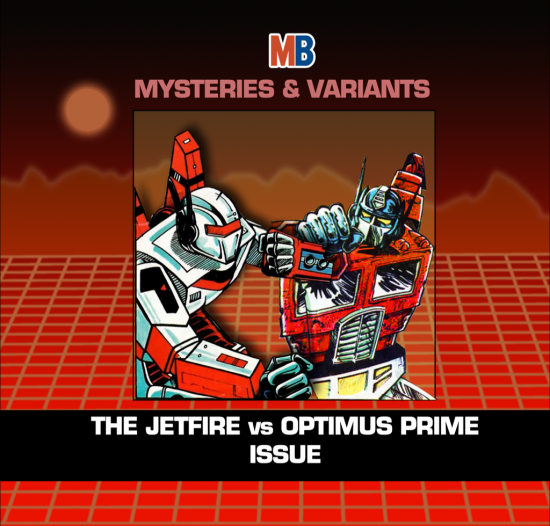
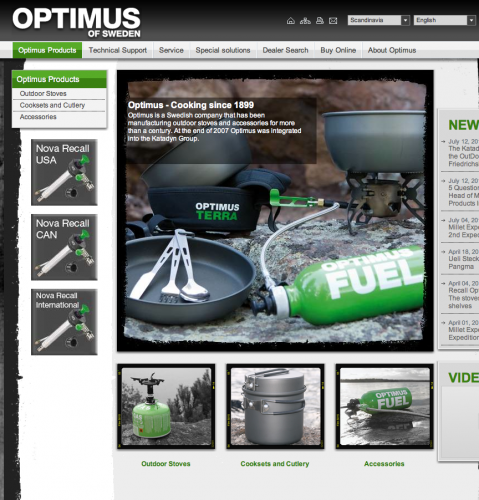
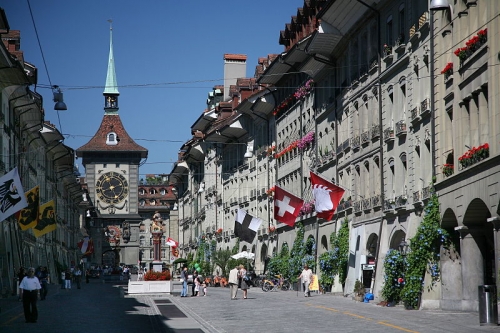
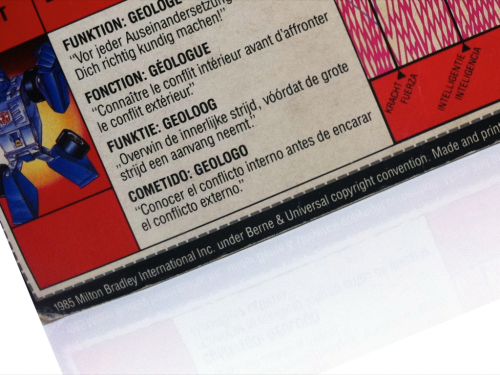
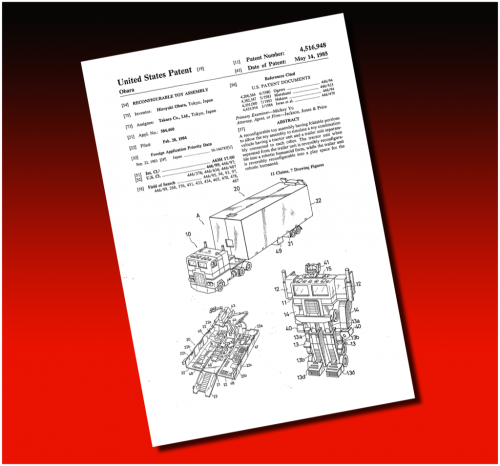
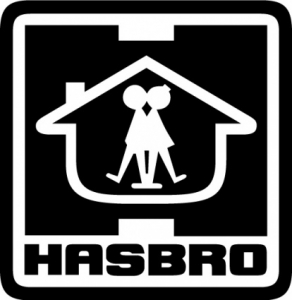
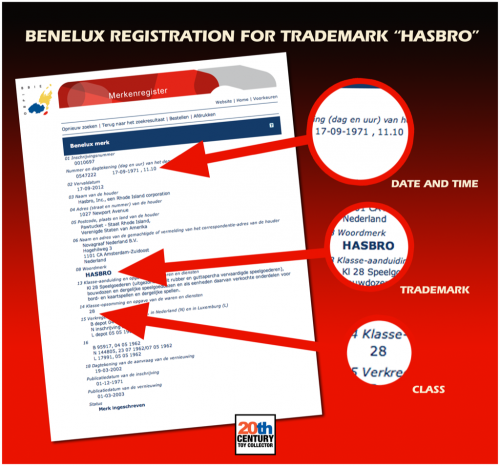
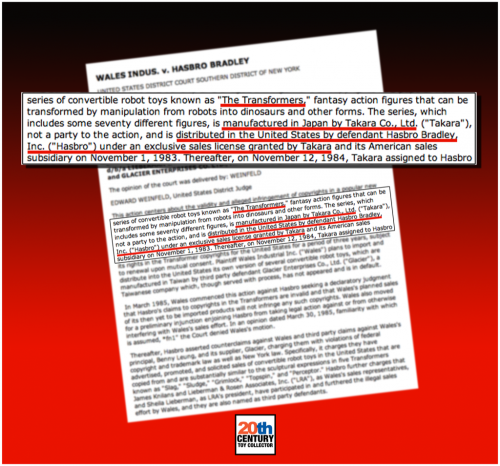
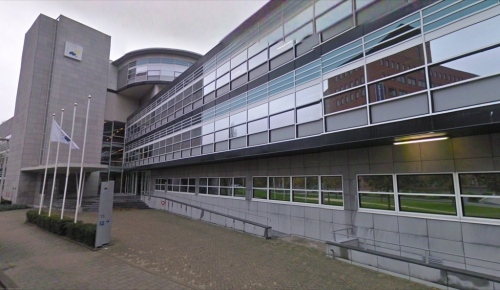
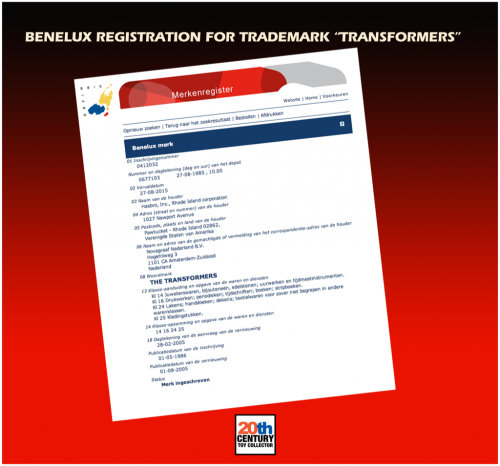
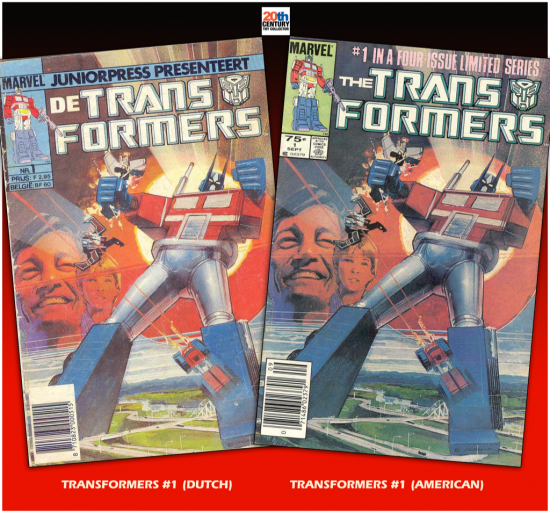
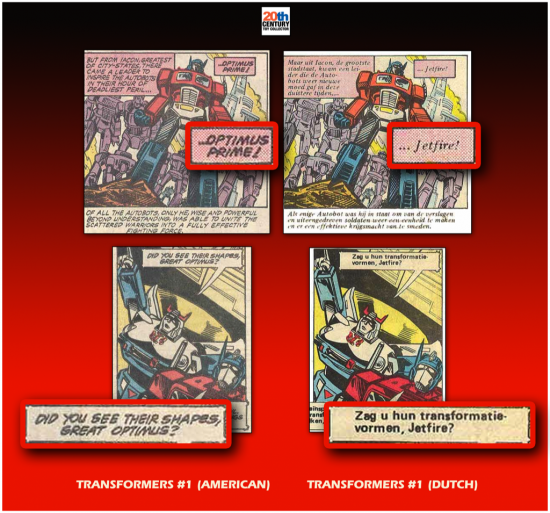
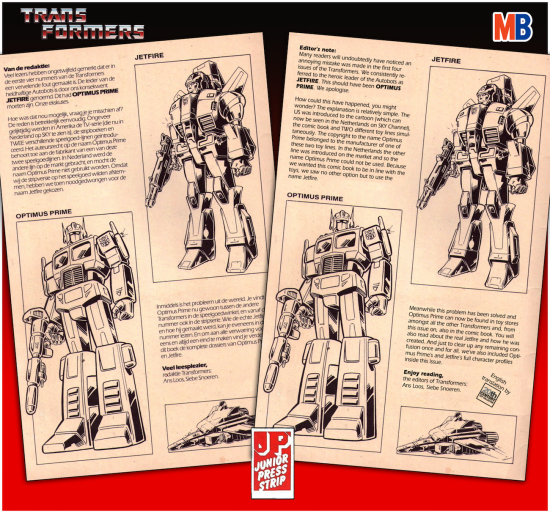
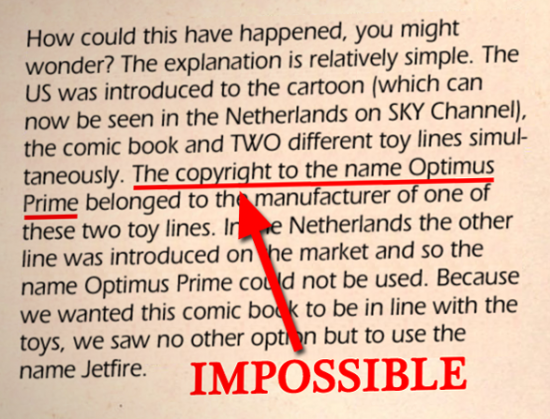
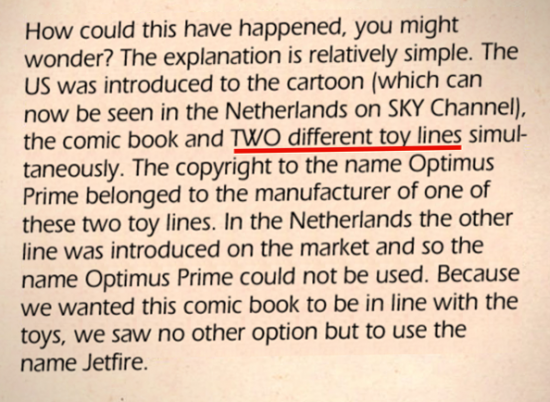

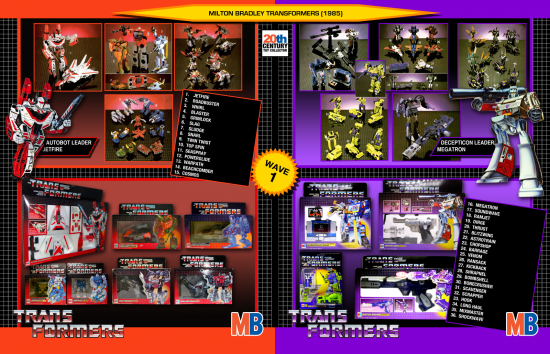
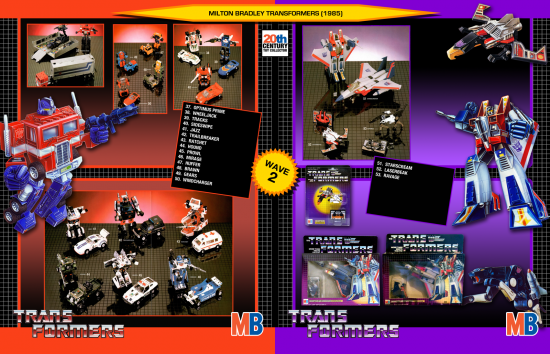
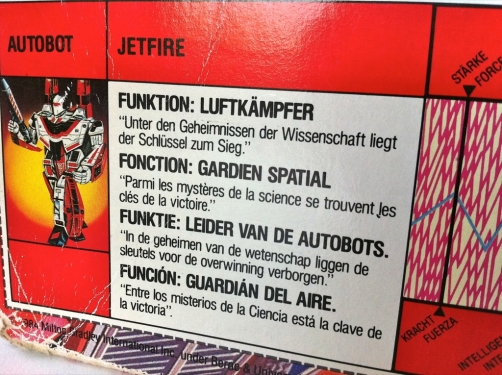
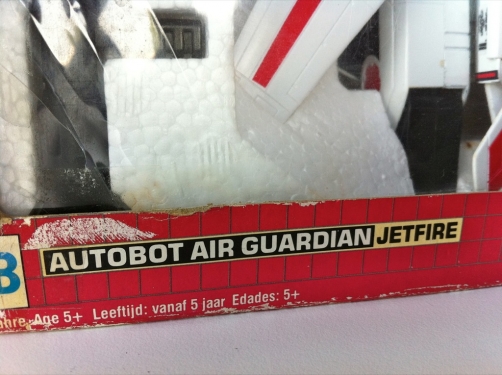
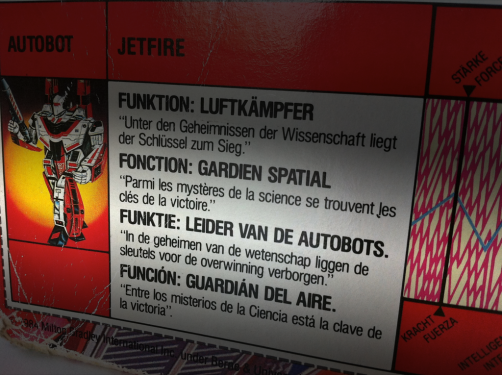
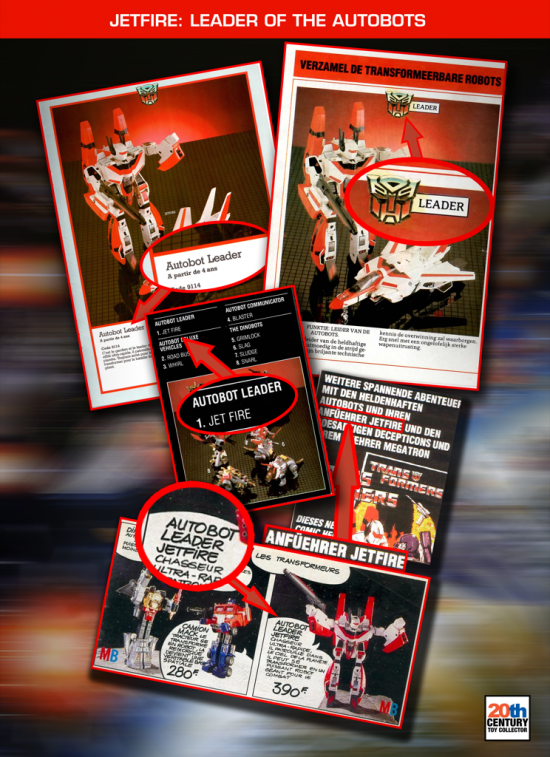

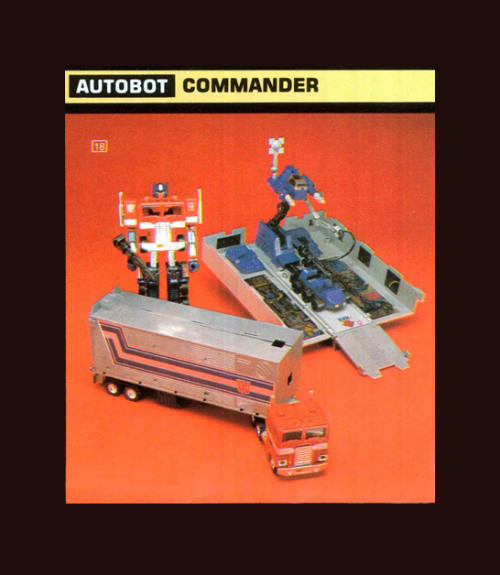
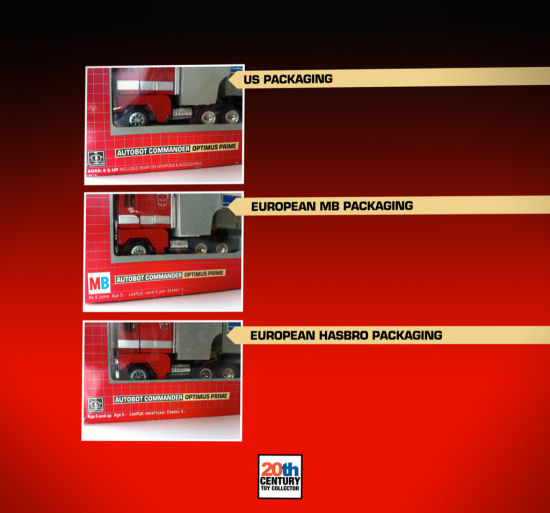
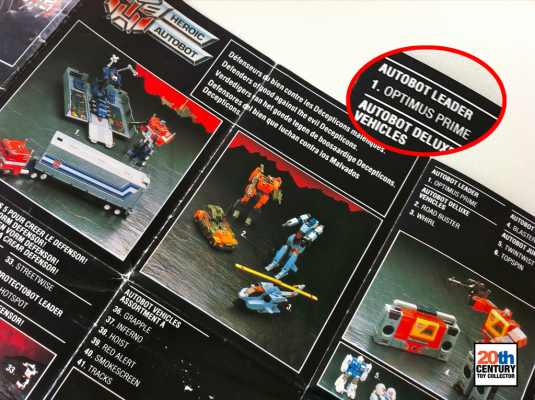
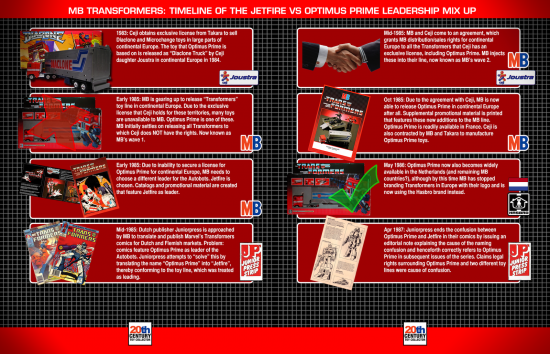

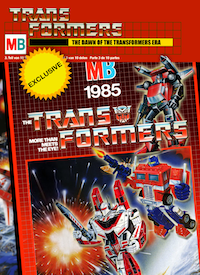
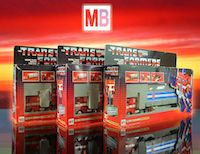

thank you for the lessons in IP law! ;) most expertly written article on the jetfire v.s. optimus prime thing i’ve seen. great info on the sales exclusivity. highly anticipating your next article.
– art (bbps3)
Thanks for another great article! Always a please to read something so well-researched and thorough on the early history of Transformers and MB/Joustra. :)
I think I may have a theory on why MB Prime was released so late in wave 2. Looking at how MB Tracks initially was red, and – as estabilshed in one of your earlier articles – that MB was using up Joustra’s remaining stock for that, I think it wouldn’t be far off to surmise, that MB wanted to use Joustra’s remaining stock for the Prime toy as well, but couldn’t, since it featured the large “Diaclone” stickers on the trailer. Hence, MB had to wait for new stock to be produced with the correct TF trailer stickers, before they could release him.
Considering the old “overstock” legend (another TF urban myth, which I personally dismiss because of the following), it is highly uneconomical to unpack old stock, remove specific stickers, add new ones and then re-pack them in TF packaging (this is the myth regarding early US TF releases in regards to old Microman/Diaclone stock). It would be simpler, cheaper and faster to re-rig the production machinery to use the new stickers and the new packaging, and dispose of the old stock instead.
For whatever reason, the red Corvette could be reused by MB initially (perhaps they noticed him in red on the 1985 back-of-box mural), and MB decided that it was easier to repack Joustra stock (without modifying the toys, or even using US style bubble inserts), possibly to get on to the market fast instead of waiting for new stock to be made.
On that note, has a red Joustra Sunstreaker ever been confirmed? I know that no packaged sample has appeared yet, so we only have the sales catalog pictures to go by, but it would be safe to assume that this toy would be red for Joustra. If my above theory with the repacking holds water, there might be a MB red Sunstreaker out there as well, but that may be something you are covering in your next article(s)… ;)
Thanks!
– Fighbird
Joustra Sunstreaker is yellow, as is the boart for Joustra Sunstreaker. Confirmed by two former owners, but no photographic proof :(
By the way Hi Martin :)
By the way AWESOME ARTICLE Mijo!!!!
All the best
Maz
Oh wait there is photographic proof here:
http://i56.tinypic.com/1zozuhd.jpg
Those loose toys are all Joustra Diaclones.
All the best
Maz
Hi Maz ;-)
Ah, should have remembered the yellow ‘Streaker from that particular picture.
Interesting where that yellow color came from, methinks, considering that the Corvette stayed yellow… what was GiG up to at that point?
– Fighbird (Martin)
@bbps3: Thanks for the kind comments.
@Fighbird: Thanks for your well thought out comment! It’s the perfect excuse for me to add some more info that I wasn’t able to add to the main article.
You could definitely think up scenarios where the process of removal of incorrect factory stickers and re-application of new stickers is much more expensive per unit than simply churning out new toys with correct stickers. After all you’ll have a production line to do that for you. Manual labour is more expensive than (partly) automated production lines. Removing and re-applying stickers would almost certainly had to have been a manual job, because it doesn’t make sense to invest millions in creating a sticker removal and re-application production line. :-) But there are other supply chain related costs that have to be weighed into the equation as well, depending on where the manufacturing takes place.
Taking the above into account, I agree with you that restickering was very unlikely to have happened. But there’s another scenario thinkable that does not involve restickering (and thus it being responsible for the delay in the availability of Optimus Primes) and that is the possibility that Ceji Joustra already had stock of Optimus Primes with Autobot stickers on the sides instead of the Diaclone stickers. Whether these were originally intended for sale inside Joustra Diaclone packaging remains debatable, but not impossible in my opnion, because we’re talking about a company (Ceji Joustra) which was not overly concerned with details (their minibots came with Autobot stickers, their F-15 had pre-Thundercracker colours on the packaging, but came with pre-Starscream inside the box, they advertised a pack-in mini-comic book on the packaging of their Diaclone line while many of these never came with comic books, they produced a red foot variant Optimus Prime, they produced yellow-variant Constructicons, they put the red Tracks into MB boxes, put Thundercrackers in MB Starscream boxes and Sunstreakers in MB Sideswipe boxes. Phew!) Where was I? :-) Ah yeah, the possibility of Joustra possessing OPs with factory Autobot stickers on the trailer.
In the relatively short time that I have been collecting MB Transformers (two and a half years) I have come across 12 Optimus Primes in MB packaging. I’ve seen three variants: (1) Made in Japan by Takara, packaging printed in France by Cajofe: This one has the grey roller and the metal plates on the inside of the trailer (2) Made by Ceji and printed by Cajofe in France: Red foot variant. (3) Also made by Ceji, identical packaging: but now OP with normal blue feet. I’ve seen 4 of the first variant (Takara metal trailer), 6 of the second variant (Ceji red foot) and 2 of the third variant (Ceji blue foot). The MB packaging for all three is nearly identical except for variant 1 having a different notice on the box (Made in Japan). The other two (by Ceji) have identical packaging. Another interesting observation is that all of these come with the same Cajofe date code on the inside flap of “09 85”, indicating that the packaging for these was all printed (or initially designed) around September 1985.
Variants 2 and 3 were clearly made by Ceji (Joustra) themselves for MB, but variant 1 was most likely already in posession of Joustra as part of their Diaclone license with Takara and became part of MB’s and Ceji Joustra’s deal to take over stock they had (or was alloted to them by Takara). Why have the packaging printed in France otherwise? My head hurts… :-)
@Maz: Thx buddy! :-)
As always a stellar job on the article! The amount of research and work you put into each segment continues to impress. Good luck with the next sections, I’ll be eagerly waiting!
@Arkvander: Thx buddy! :-)
Hi Mijo,
Thanks for your elaborate response – and a pox on me for forgetting the French made MB Optimus Prime (and kudos to you for responding to my random ramblings). :)
You make an excellent point regarding the TF symbols on the smaller Joustra Diaclone toys and other crazy stuff that Joustra did, so I appreciate the thought that they might not have cared less if Prime’s trailer said “Diaclone” on the sides or not for the TF run.
It is still curious by your added comments, though, that the initial MB releases were Takara manufactured. If indeed this variant 1 was released first, I think it lends credit to the fact that Joustra might only have had masters to make trailers with “Diaclone” stickers, and in order to release a “correct” Optimus Prime (with the correct trailer stickers, since the Diaclone brand was “dead” in favour of the new “Transformers” brand), Takara supplied them with TF stock while Joustra were preparing to make TF Primes themselves. I know it’s a bit of a long shot, especially considering that we are talking about changing 2 sticker designs in order to make “proper” TF Primes, but it might have been a bigger deal than that – especially considering that the first French made MB Primes had the red feet.
I’m having a bit of a hard time getting into my head why Ceji Joustra would have Takara stock of TF Primes ready for their Diaclone line, since A) they were producing the Diaclone Primes themselves in France, and B) they had only licensed the Diaclone version/molds/prints from Takara. Could be me that’s missing something here (I’m known for that; just ask Maz… ;-).
I can’t wait to see your info on the MB Sunstreaker, and if you have something in regards to why he was yellow going all the way back to Ceji Joustra; this was what I was musing about in the message above: Why the Countach Super Tuning was yellow, while the Corvette was red (whote “yellow” earlier by mistake). Can’t really remember what color GiG’s Super Tuning was being released in at that time, while it also could be interesting to see what a possible (existance not confirmed in any capacity) Finnish Diaclone Countach would have been colored like.
Thank you again for your great work, and also for a nice constructive conversation here. :)
– Martin
Pleasure’s all mine, Martin. :-) Regarding the Ceji Joustra Primes: As far as I know, Ceji never manufactured the Diaclone Truck (i.e. Battle Convoy with Diaclone stickers) themselves. These were all made by Takara. Ceji only started manufacturing transforming robots after the Transformers line was launched, i.e. they never made any Joustra Diaclones, only Transformers for Hasbro/MB. When Ceji Joustra was selling Diaclone Primes, they were not manufacturing them, but getting them straight from Takara. (I’m using the names Ceji, Joustra and Ceji Joustra interchangably here. I need to stop doing that and settle on one name:-)
I don’t feel knowledgeable enough to comment on the GiG line. All I can say is that I see a lot of similarities between the moulds and colourings they had compared to the Joustra Diaclone line, which is not so surprising as they both had contracts with Takara to supply them with said toys around the same time. Maz recently also discovered some interesting information which ties GiG back to Joustra, but I’ll leave it to him to publish that info. :-) It is very interesting, to say the least, how all these European players (MB, Ceji Joustra, GiG) were connected to each other in the early Transformers days.
Another piece of mind blowing Euro TF info. You are writing history my friend. I have started collecting MB TFs and Joustras because of these articles. Could you please email me regarding some MB info I’m after?
Just stepped into these articles. I am awestruck. Your last 2 articles have been amazing. Youve raised the bar to new heights for yourself.
I LOVE the way you present information and how you back up your theory’s… all in a respectful manner. While I may not agree with each and every point you make, I am convinced that 95% of what you claim is true and the the remaining 5 are very close to the mark. Well done.
Great info. Thank you for this info about euro transformers. I am from spain and I love seeing this information of MB transformers. I am also waiting for la proxima vez! ;-)
I think the original (?) source of the “Optimus” rumor is this:
http://www.fredsworkshop.com/veuro2.html
The German in that MB catalog is also wonky. “Anfüehrer”? Either you use an umlaut “ü” or the substitute “ue”, but not both at once.
LOL. Yeah. Some really dodgy translation there. I would love to see the rest of that German catalog (unfortunately I only have a scan of that page). It’s the German version of the store catalog (a.k.a. the mini-comic).
Have you seen this page? http://www.tf-1.com/articles/pretf/joustra_template.html
Maz has quoted me in that article and I contributed the translation of the Eppo ad, so yeah I have. ;-) Great article too. For me the most interesting part is what happened to the non-pre-Transformers Diaclones and how some of those ended up with GiG!
I really don’t mind who is the leader. All I need to konw is: why Jetfire is the VF-1 from Macross (Robotech)…?
After the major hit that Transformers became in 1984 Hasbro wanted to expand the line drastically for 1985. Hasbro wanted more transforming robots than Takara could offer them at that point in time, so Hasbro sourced product from other Asian manufacturers (competitors of Takara) like Bandai and ToyCo. Bots like Jetfire, Shockwave and Omega Supreme are examples of those.
Hi you all.
I have nr.1 of the Juniorpress.
I haven’t got a clue what it’s worth these days.
It has been in a closet for decades.
I don’t need it anymore and may sell it to anybody who’s interested
My email is natshirt79@gmail.com